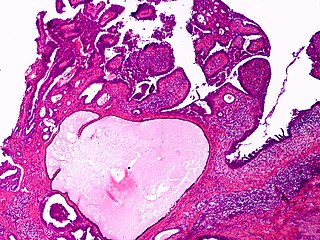
Blue nevus is a type of melanocytic nevus. The blue colour is caused by the pigment being deeper in the skin than in ordinary nevi. In principle they are harmless but they can sometimes be mimicked by malignant lesions, i.e. some melanomas can look like a blue nevus.

Hidrocystoma is an adenoma of the sweat glands.
Eccrine angiomatous hamartoma (EAH), first described by Lotzbeck in 1859, is a rare benign vascular hamartoma characterized histologically by a proliferation of eccrine and vascular components. EAH exists on a spectrum of cutaneous tumors that include eccrine nevus, mucinous eccrine nevus and EAH. Each diagnostic subtype is characterized by an increase in the number as well as size of mature eccrine glands or ducts, with EAH being distinguished by the added vascular component.

Nevus anemicus is a congenital disorder characterized by macules of varying size and shape that are paler than the surrounding skin and cannot be made red by trauma, cold, or heat. The paler area is due to the blood vessels within the area which are more sensitive to the body’s normal vasoconstricting chemicals.

Nevus sebaceus or sebaceous nevus is a congenital, hairless plaque that typically occurs on the face or scalp. Such nevi are present at birth, or early childhood, affecting males and females of all races equally. The condition is named for an overgrowth of sebaceous glands in the area of the nevus.

Syringocystadenoma papilliferum is a benign apocrine tumor.
Pigmented hairy epidermal nevus syndrome is a cutaneous condition characterized by a Becker nevus, ipsilateral hypoplasia of the breast, and skeletal defects such as scoliosis.

Nevus spilus is a skin lesion that presents as a light brown or tan macule, speckled with smaller, darker macules or papules.. Prevalance is around 2%, according to a limited study by Kopf et al
A benign melanocytic nevus is a cutaneous condition characterised by well-circumscribed, round or ovoid lesions, generally measuring from 2 to 6 mm in diameter.
Papillary eccrine adenoma is a cutaneous condition characterized by an uncommon benign sweat gland neoplasm that presents as a dermal nodule located primarily on the extremities of black patients.

Syringofibroadenoma is a cutaneous condition characterized by a hyperkeratotic nodule or plaque involving the extremities.

Apocrine gland carcinoma is a cutaneous condition characterized by skin lesions which form in the axilla or anogenital regions.
Woolly hair nevus is a congenital condition in which hair in a circumscribed area of the scalp is kinked or woolly.

Melanoma with features of a Spitz nevus is a cutaneous condition characterized histologically with tissue similar to a spitz nevus and with overall symmetry and a dermal nodule of epithelioid melanocytes that do not mature with progressively deeper dermal extension.

Small-cell melanoma, also known as melanoma with small nevus-like cells, is a cutaneous condition, a tumor that contains variably-sized, large nests of small melanocytes with hyperchromatic nuclei and prominent nucleoli.
Porokeratotic eccrine ostial and dermal duct nevus is a skin lesion that resembles a comedonal nevus, but it occurs on the palms and soles where pilosebaceous follicles are normally absent. It is probably transmitted by paradominant transmission.

Nevoid melanoma is a cutaneous condition that may resemble a Spitz nevus or an acquired or congenital melanocytic nevus.











